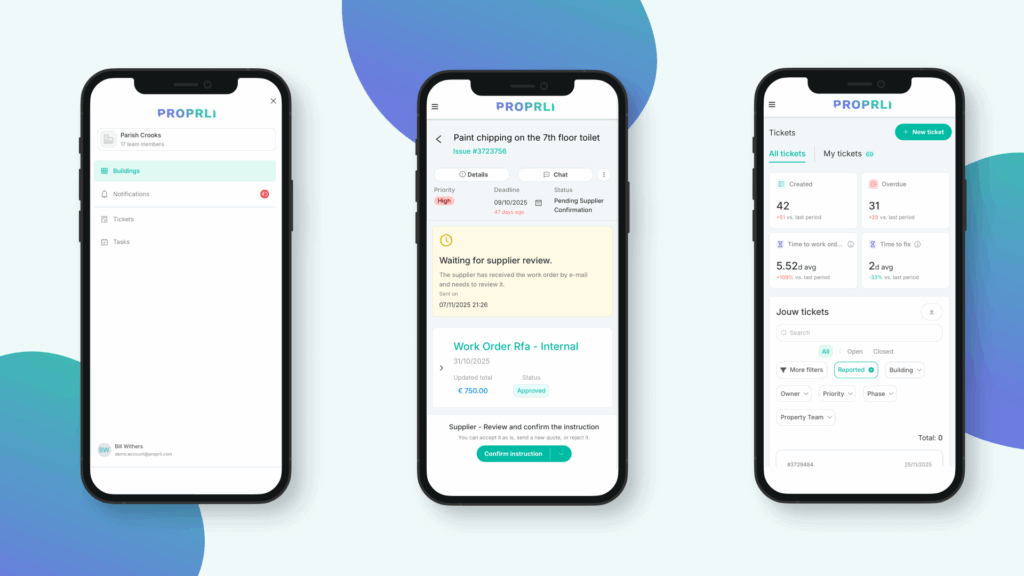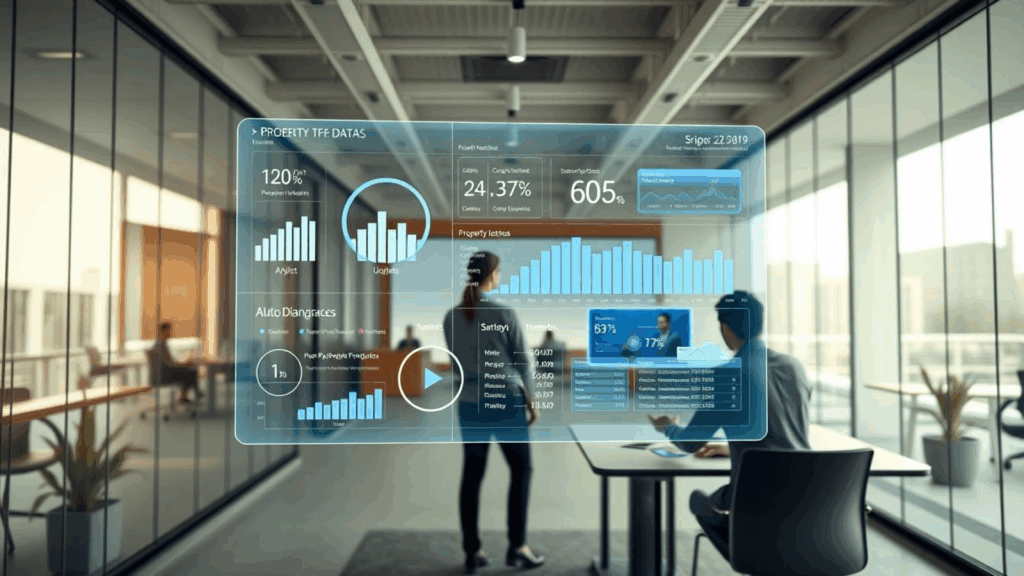In the realm of property management, focusing on business efficiency is vital. Key Performance Indicators (KPIs) serve as crucial tools for assessing a company’s health. They spotlight areas like revenue growth and tenant turnover. When assessed against previous results and industry standards, these KPIs offer deeper insights.
Adopting technology and generating custom reports allow property managers to track and evaluate these metrics accurately. This strategy not only fosters strategic growth but also boosts the quality of property oversight. Recognizing and enhancing these indicators is a pivotal move towards refining property management efficiency.
Key Takeaways
- Monitoring business efficiency is crucial for property management companies of all sizes.
- KPIs like revenue growth and tenant turnover help gauge company health.
- Comparing KPIs with industry peers provides valuable insights.
- Utilizing technology can streamline the tracking and analysis of performance metrics.
- Strategic, cost-effective growth results from well-monitored key performance indicators.
Introduction to Property Management Efficiency
Efficiency stands as a critical factor in property management, vital for sustaining competitiveness and securing real estate investments’ profitability. To stay ahead in the rapidly changing landscape, adopting strategies to boost efficiency is key. Focus on efficient management techniques and monitoring key performance indicators (KPIs). These steps significantly improve operational outcomes.
Importance of Efficiency
Efficiency bears a direct influence on financial gains and the sustainability of operations within property management. Monitoring key performance indicators such as cost per lease, occupancy levels, and speed of maintenance response is crucial. By analyzing these metrics, managers can pinpoint improvement areas and refine resource utilization. Enhanced processes and minimized waste lead to increased profitability and better tenant relations.
Role of Technical Management
Technical managers hold a key position in enhancing efficiency within property management. They are vital in keeping properties functional and advancing their development. Balancing immediate tasks with strategic planning ensures operations run smoothly.
Their work includes strategic oversight and swift problem resolution, aiming for optimal management efficiency. Emphasizing technical management’s importance aligns with broader business goals, promoting overall success.
Key Performance Property Management KPIs
Measuring the success of property management relies heavily on specific KPIs. Monitoring these indicators, firms can achieve growth and better efficiency. Among the most significant are Revenue Growth and Tenant Satisfaction Ratings. They provide insights into a firm’s health and areas that require focus.
Revenue Growth
Revenue growth is a key indicator of success in property management. It allows managers to see trends by comparing annual data. Strategic decisions are made from these insights, aiming to improve practices. Steady revenue growth shows a firm’s management strategies are working and indicates financial stability.
Tenant Satisfaction Rating
Tenant satisfaction is crucial for quality service assessment. High satisfaction levels decrease turnover and extend tenancy periods, improving the firm’s reputation. By evaluating feedback regularly, managers can align services with tenant needs. This approach raises satisfaction and enhances overall performance.
Key KPIs for property management, like Revenue Growth and Tenant Satisfaction Ratings, show a firm’s position in the market. They highlight improvement opportunities. Targeting these areas ensures firms grow in a sustainable, strategic manner.
| Key Performance Indicator | Importance | Measurement |
|---|---|---|
| Revenue Growth | Crucial for financial health and strategic decisions | Year-over-Year Comparison |
| Tenant Satisfaction Ratings | Vital for long-term tenancies and reputation | Regular Feedback Collection |
Strategies for Reducing Tenant Turnover
For property management, reducing tenant turnover is key. Effective strategies center on better communication and fast maintenance and repairs. These are critical benchmarks for a well-run operation.
Enhancing Communication
Trust and satisfaction grow from clear, transparent communication. Regular updates, easy feedback channels, and quick replies help keep tenants. Such communication makes tenants feel valued, creating a stable, pleasant living space.
Maintenance and Repairs
Timely maintenance and repairs greatly affect tenant happiness. A proactive maintenance routine, coupled with swift repair responses, builds trust. It not only keeps tenants but also safeguards the property’s long-term value.
- Conduct regular property inspections to identify and address potential issues before they escalate.
- Set clear timelines for completing maintenance tasks and communicate these to tenants.
- Offer a convenient system for tenants to report maintenance issues and track the progress of their requests.
By prioritizing communication and upholding maintenance standards, property managers set powerful strategies to cut tenant turnover. These practices are crucial, ensuring tenants are satisfied and stay longer.
Maximizing Occupancy and Reducing Vacancy Rates
Achieving high occupancy and low vacancy rates is crucial for property managers. It mirrors their success in employing effective tactics to draw and keep tenants. Essential to this mission are powerful marketing strategies and smart pricing. Let’s delve into these key approaches.
Effective Marketing Techniques
Driving occupancy through marketing is critical. A mix of digital and traditional methods boosts property visibility. Digital avenues like social media, online listings, and email campaigns reach wide and targeted audiences. Meanwhile, open houses and local events create tangible connections with the community.
Strategic Pricing
Smart pricing plays a pivotal role in maintaining full occupancy. Analyzing the market and setting competitive rents are musts for property managers. Proper pricing keeps a property appealing and helps in attracting loyal tenants. Adjusting prices in response to market dynamics maintains revenue and keeps vacancies low.
Here’s a visual example comparing various strategies:
| Marketing Technique | Impact on Occupancy |
|---|---|
| Social Media Advertising | Increases visibility among younger demographics, leading to higher inquiry rates |
| Email Marketing | Reaches existing and prospective tenants directly, improving engagement |
| Open Houses | Provides firsthand experience of the property, boosting interest and conversion |
Tracking Maintenance and Repair Completion
Maintaining a property goes beyond daily tasks. It includes keeping a detailed log of all maintenance and repair jobs. Using modern technology and preventive strategies is vital in this context.
Using Technology for Efficiency
Adopting technology is crucial for enhancing efficiency in property management. It offers advanced options for keeping an eye on maintenance activities.
With property management software, managing repair schedules, monitoring progress, and achieving on-time completion becomes simpler. This approach minimizes sudden failures and downtime, enhancing property management results.
Preventative Maintenance
Preventive maintenance plays a key role in boosting property management outcomes. Regular inspections prevent minor issues from becoming major problems. This keeps properties in great shape and avoids expensive urgent repairs.
This method not only prolongs the life of property fixtures but also improves tenant happiness. It boosts the overall efficacy of property management.
For better operational efficiency in property management, an integrated system for maintenance and repair tracking is key. Marrying proactive maintenance with quick repairs enhances property management’s effectiveness and its performance markedly.
Optimizing Rent-Ready Costs
Efficient management of costs linked with making rental units ready for new tenants is key for maintaining property management efficiency. This includes a mindful approach to budgeting and managing materials. Ensuring quality while keeping expenses in check is fundamental.
Budget Considerations
For optimizing rent-ready expenses, a clear and realistic budget is crucial. Property managers must outline budgets that encompass all vital costs but dodge unnecessary spending. This strategy ensures the unit is cost-effectively prepared, aligning with top property management practices without sacrificing quality.
Materials and Supplies Management
Managing materials and supplies effectively is critical in lowering rent-ready costs. Property managers need to build strong relationships with suppliers for favorable terms. This tactic reduces expenses while ensuring access to high-quality materials, boosting property management efficiency.
Measuring Tenant Turnover and Retention
It’s essential to grasp and better tenant retention for successful property management. Regular assessment of tenant turnover and the adoption of impactful retention methods can drastically lower new tenant acquisition costs. This part explores how to benchmark turnover rates and outlines key tenant-keeping strategies.
Benchmarking Turnover Rates
Benchmarking the rates of tenant turnover offers insights into your retention strategy’s effectiveness. Comparing your figures with the industry’s reveals improvement areas. Ideally, turnover should be between 10% and 20% yearly. Keeping an eye on these rates enables property managers to use data in keeping their turnover rates competitive.
| Year | Turnover Rate |
|---|---|
| 2021 | 15% |
| 2022 | 18% |
| 2023 | 12% |
Retention Strategies
To minimize tenant turnover, executing fruitful retention plans is crucial. Key methods include improved interaction, swift maintenance response, and establishing a sense of community. Conducting tenant satisfaction surveys can offer direct feedback, helping to refine services. Prioritizing solid ties with tenants boosts the likelihood of lease renewals.
- Enhance Communication: Ensure clear, consistent communication with tenants.
- Maintenance Responsiveness: Address maintenance concerns without delay.
- Community Building: Cultivate community through various activities and programs.
By applying these strategies, property managers can curb tenant turnover. This leads to a more reliable tenant base and boosts property financial health.
Improving Financial Performance Metrics
For property management success, it’s crucial to concentrate on key financial metrics. Net Operating Income and Rent Collection Rates stand out as essential. These indicators are pivotal for financial prosperity.
Net Operating Income
Net Operating Income (NOI) is a core marker of property profit. It involves balancing operating costs against gross rental earnings. Spotting efficiency improvements is possible through this comparison. Maximizing NOI is vital for enhancing property management financial outcomes.
Rent Collection Rates
Rent Collection Rates significantly affect a property’s financial stability. Enhancing rent collection practices boosts cash flow reliability. Employing effective strategies and ensuring clear tenant communication is crucial. Such actions lead to better management outcomes and financial health.
| Metric | Description | Importance |
|---|---|---|
| Net Operating Income (NOI) | Difference between revenue generated and operating expenses | Indicates profitability and helps guide expense minimization strategies |
| Rent Collection Rates | Percentage of collected rent compared to the total possible rent | Essential for maintaining stable cash flow and fiscal health |
Analyzing these metrics guides property managers towards strategic decisions. Focusing on NOI and Rent Collection Rates propels financial growth. Such attention ensures elevated management efficiency and profitability.
Efficient Work Order Management
An efficient work order management system is key for better property management. It streamlines operations and increases tenant happiness. Thus, saving resources.
Tracking Work Order Completion Rates
Key to this is tracking work order completion diligently. Doing so, property managers can address issues quickly. It helps in finding areas that need work too. This tracking boosts transparency and efficiency in managing properties.
Enhancing Tenant Self-Service Options
Boosting self-service for tenants is crucial. Allowing them to submit work orders online enhances service speed and precision. This boosts their satisfaction and makes resource use more efficient. It’s a big step towards better management.
| Management Aspect | Benefits |
|---|---|
| Tracking Work Order Completion Rates | Improves transparency, ensures timely issue resolution, enhances efficiency. |
| Enhancing Tenant Self-Service Options | Boosts tenant satisfaction, optimizes resources, accelerates service delivery. |
Using Technology to Track Property Management KPIs
Embracing technology has transformed property management monitoring. It provides managers with instant access to key performance indicators (KPIs). Now, they can more easily spot trends, uncover inefficiencies, and spot improvement opportunities. This change fosters a deeper and more precise understanding of property performance.
Automated reporting tools are crucial for quick and exact data analysis. With such technology, managers receive detailed reports on crucial metrics. These insights allow for comparison against benchmarks and focus on actionable strategies. Thus, they guide informed decision-making.
Through a technology-driven methodology, monitoring becomes streamlined, and setting benchmarks becomes informed. Integration of such technology is vital for proactive management. It focuses on refining operations and boosting overall performance. Adopting technological solutions is key to enhancing efficiency. It supports continued growth in the dynamic real estate sector.
FAQ
What are the primary key performance indicators (KPIs) in property management?
Key performance indicators in property management focus on several vital areas. These include revenue growth, tenant satisfaction ratings, and occupancy rates. Also important are the tenant turnover rate and rent collection rates. These metrics offer insight into the success of property management efforts, guiding improvements in efficiency.
How does efficiency impact property management performance?
Efficiency is pivotal in property management for several compelling reasons. It leads to reduced operational costs and higher tenant satisfaction. Moreover, it boosts revenue. By ensuring timely maintenance and leveraging effective communication, managers enhance property performance and market competitiveness.
Why is tenant satisfaction an important KPI?
Tenant satisfaction stands as a crucial KPI, shedding light on service quality. High satisfaction fosters retention, garners positive reviews, and minimizes vacancies. It signifies tenants’ appreciation and the prompt fulfillment of their needs.
What strategies can help in reducing tenant turnover?
Effective strategies to curb tenant turnover revolve around excellent communication and service. Promptly resolving repair issues and rolling out tenant retention programs are critical. They foster engagement, enhancing loyalty and decreasing turnover rates.
How can property managers maximize occupancy and reduce vacancy rates?
To maximize occupancy and slash vacancy rates, property managers employ several strategies. Powerful marketing and strategic pricing play pivotal roles. Aligning rents with market rates and adopting focused marketing approaches draw and retain tenants, ensuring high occupancy.
How does technology improve the efficiency of maintenance and repairs?
Technology revolutionizes maintenance and repair efficiency by enhancing task tracking and preventive maintenance practices. It offers real-time updates and streamlines work order management. This ensures swift task completion, minimizes breakdown risks, and curbs expenses.
What are key considerations in optimizing rent-ready costs?
In optimizing rent-ready costs, effective budget and materials management are essential. Grasping these costs enables managers to prepare units for new tenants efficiently. This strategy ensures cost-effectiveness without compromising quality, boosting management efficiency.
How can property managers measure tenant turnover and retention effectively?
For effective measurement of tenant turnover and retention, property managers rely on benchmarking and strategy implementation. By evaluating turnover rates and integrating effective retention tactics, managers address dissatisfaction. This allows for focused improvements in retention.
What are important financial performance metrics in property management?
Crucial financial metrics in property management include net operating income and rent collection rates. These indicators offer insights into the financial state of the property portfolio. They guide strategic decision-making to heighten profitability and operational efficiency.
How can work order management enhance property management efficiency?
Enhancing property management efficiency through work order management involves several key actions. Tracking completion rates and improving tenant self-service options are foundational. Employing technology for work order submission and tracking elevates efficiency. It also boosts tenant satisfaction and conserves resources.
Why is using technology to track property management KPIs important?
Employing technology in tracking property management KPIs is essential for streamlined monitoring. It ensures access to current performance data of the portfolio. Automated tools and software support a data-driven strategy. This approach aids in setting precise success benchmarks and fosters proactive management.






